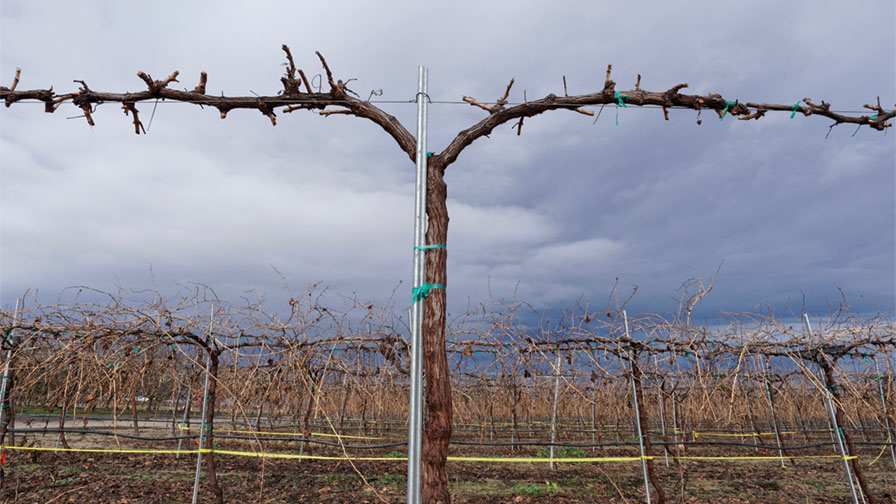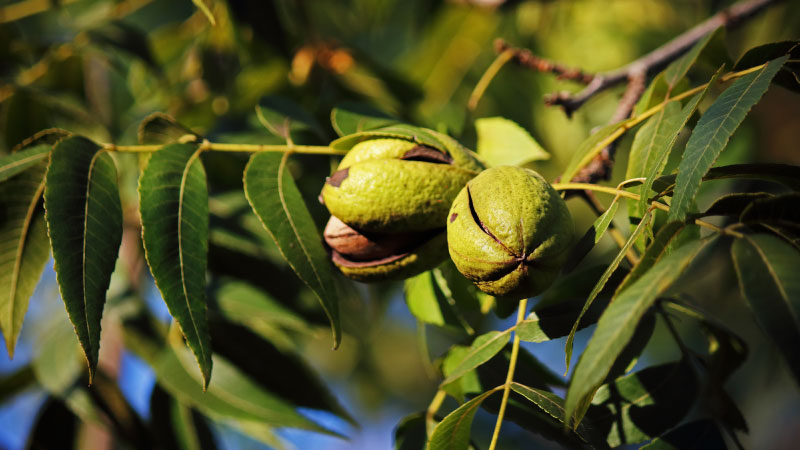Early Ripening Grapes Could Revolutionize Raisin Production

The foreground of this picture shows one of two trellises being tested for ‘Sunpreme’ — a high-wire bilateral system. In the background is the other trellis being trialed, a quadrilateral cordon system. (Photo: Matthew Fidelibus)
The USDA-ARS raisin grape breeding program has long focused on the development of early ripening varieties. Early ripening allows drying to begin sooner, thus helping to avoid inclement weather and enable production of dry-on-vine (DOV) raisins. ‘Fiesta’ and ‘Selma Pete’ are examples of early ripening raisin grapes from the USDA that have helped change the way California raisins are made.
‘Sunpreme,’ the most recent variety to be released from this program, could have even more profound effects on the California raisin industry due to two unique and highly desirable traits: spontaneous natural drying, and fruitful basal buds. These traits could enable ‘Sunpreme’ to be harvested and pruned by machines, greatly reducing the need for manual labor. However, ‘Sunpreme’ also has a unique undesirable trait, preharvest fruit drop (shatter). Thus, there is a high interest in ‘Sunpreme,’ tempered somewhat by a lack of information on potential productivity and shatter.
Preliminary research suggested that deficit irrigation and cropload affect the quality of ‘Sunpreme’ grapes and raisins. That research was conducted on own-rooted vines, but growers are likely to use rootstocks to protect against soil pests, so the performance of ‘Sunpreme’ on rootstocks should be tested. Optimal trellising for ‘Sunpreme’ is unknown, but trellises that facilitate mechanical pruning and harvesting are desirable.
In previous research, spur-pruned vines with quadrilateral cordons performed as well as head-trained cane-pruned vines grown on the same 32-inch wide two-wire trellis. Spur pruning is more easily mechanized than cane pruning, but quadrilateral cordon systems are less amenable to mechanization, the trellis is more expensive, and vines require more training and take longer to fill the trellis, compared to a bilateral cordon system. Therefore, we initiated a study at the University of California, Kearney Agricultural Research and Extension Center in Parlier, CA, to determine how ‘Sunpreme’ raisin grapes perform on different rootstocks and quadrilateral or bilateral trellis systems. The following summarizes the key findings from 2017, the first year of our study.
Evaluating ‘Sunpreme’
Rootstocks affected the uptake of many macro and micronutrients. Vines on 1103P had the lowest levels of potassium (K) and the highest levels of zinc (Zn), magnesium (Mg), and manganese (Mn). Vines on 1103P, or Freedom rootstock, had lower levels of Sodium (Na) and higher levels of Calcium (Ca) than own-rooted vines. Rootstock effects on nutrient uptake are generally similar to effects observed in previous rootstock studies in which those two stocks were compared.
Rootstocks also had some minor effects on berry weight and composition. Berries from vines on either rootstock matured slightly quicker than those on own-rooted vines, and the raisins from vines on rootstocks were slightly drier at harvest than raisins from own-rooted vines. Vines on 1103P also had slightly less preharvest fruit drop than own-rooted vines, but more data will help determine if such effects are consistent.
Some vines were thinned by removing approximately 40% of the clusters at berry set to determine how crop load might affect yield and quality of young vines. Thinning increased berry weight but reduced soluble solids. Thinning also reduced yield by 25%, but did not affect raisin quality, and thinned and non-thinned vines appeared to grow equally well. Thus, thinning might be unnecessary on vigorous young vines, though pruning weights and return fruiting information is needed before firm conclusions can be made.
At veraison, vines on quadrilateral trellises had lower K than vines on bilateral trellises, possibly due to the vines on T-trellises having higher yields than those on the single high wire trellises (2.5 versus 4 tons/acre, respectively). Raisins were high quality, less than 80% B and better grades. Preharvest fruit drop was approximately 10%, with another 5% to 10% loss during mechanical harvest.










